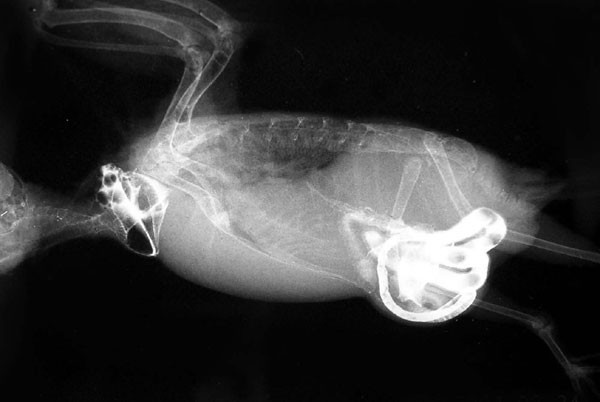Diagnosis: abdominal mass with abdominal hernia
- Select a language for the TTS:
- UK English Female
- UK English Male
- US English Female
- US English Male
- Australian Female
- Australian Male
- Language selected: (auto detect) - EN

Play all audios:

Access through your institution Buy or subscribe Respiratory distress, dyspnea, and tachypnea are common signs in sick birds and can be associated with a space-occupying lesion in the
coelemic cavity. The absence of a diaphragm means that any mass can compress the lungs and air sacs, causing respiratory problems. Besides an enlarged liver, neoplasia, and ascites, common
space-occupying lesions in the coelemic cavity include an egg and enlarged reproductive tract. Consequently, the sex of a budgerigar is important when considering the possible source of a
mass within the abdomen. A reproductive mass in a female budgerigar carries a better prognosis than a gastrointestinal or hepatic mass in either sex. Another cause of respiratory distress in
budgerigars is pulmonary infection, and the high white blood cell count suggested that this might be the case in this bird. Common infections include Chlamydophila (previously know as
Chlamydia) and aspergillosis. Abdominal hernias in psittacine birds may be congenital or acquired, although the definitive etiology is unknown16,17. Abdominal herniation occurs most commonly
in female psittacine birds, particularly in budgerigars. The hernia is frequently associated with weakening of the abdominal musculature associated with egg laying, egg-binding, dystocia,
or hyperestrogenism16,17. In chronic egg-laying hens, alterations in calcium metabolism contribute to muscular atony and distension of the caudal abdomen. Hernias in either sex can result
from trauma, straining, or abdominal masses16,17. This is a preview of subscription content, access via your institution ACCESS OPTIONS Access through your institution ADDITIONAL ACCESS
OPTIONS: * Log in * Learn about institutional subscriptions * Read our FAQs * Contact customer support REFERENCES * Garner, J.P., Meehan, C.L. & Mench, J.A. Stereotypies in caged
parrots, schizophrenia and autism: evidence for a common mechanism. _Behav. Brain Res._ 145(1–2), 125–134 (2003). Article Google Scholar * Wells, R.E., Slocombe, R.F. & Trapp, A.L.
Acute toxicosis of budgerigars (Melopsittacus undulatus) caused by pyrolysis products from heated polytetrafluoroethylene: clinical study. _Am. J. Vet. Res._ 43(7), 1238–1242 (1982). Google
Scholar * Wells, R.E. & Slocombe, R.F. Acute toxicosis of budgerigars (Melopsittacus undulatus) caused by pyrolysis products from heated polytetrafluoroethylene: microscopic study. _Am.
J. Vet. Res._ 43(7), 1243–1248 (1982). Google Scholar * Sato, C., Katumata, A., Takashima, I. & Hashimoto, N. Cloning and antigenic expression of two genes from Chlamydia psittaci
avian strain. _FEMS Microbiol. Lett._ 80(2–3), 201–206 (1991). Article Google Scholar * Imai, Y. Evaluation of the polymerase chain reaction to detect Chlamydia psittaci DNA. _Jpn. J. Vet.
Res._ 41(1), 17 (1993). Google Scholar * Seki, C., Takashima, I., Arikawa, J. & Hashimoto, N. Monoclonal antibodies to Chlamydia psittaci: characteristics and antigenic analysis.
_Nippon Juigaku Zasshi_ 50(2), 383–393 (1988). Article Google Scholar * Takahashi, T., Takashima, I. & Hashimoto, N. Immunotyping of Chlamydia psittaci by indirect immunoflurescence
antibody test with monoclonal antibodies. _Microbiol. Immunol._ 32(3), 251–263 (1988). Article Google Scholar * Brown, S.D. & Dooling, R.J. Perception of conspecific faces by
budgerigars (Melopsittacus undulatus): I. Natural faces. _J. Comp. Psychol._ 106(3), 203–216 (1992). Article Google Scholar * Dent, M.L., Dooling, R.J. & Pierce, A.S. Frequency
discrimination in budgerigars (Melopsittacus undulatus): effects of tone duration and tonal context. _J. Acoust. Soc. Am._ 107(5 PT 1), 2657–2664 (2000). Article Google Scholar * Hall,
W.S. et al. Cytoarchitecture of vocal control nuclei in nestling budgerigars: relationships to call development. _Brain Behav. Evol._ 53(4), 198–226 (1999). Article Google Scholar *
Kajerova, V., Literak, I., Bartova, E. & Sedlak, K. Experimental infection of budgerigars (Melopsittacus undulatus) with a low virulent K21 strain of Toxoplasma gondii. _Vet. Parasitol._
116(4), 297–304 (2003). Article Google Scholar * Fattaey, A., Lenz, L. & Consigli, R.A. Production and characterization of monoclonal antibodies to budgerigar fledgling disease virus
major capsid protein VP. _Avian Dis._ 36(3), 543–553 (1992). Article Google Scholar * Rihs, H.P., Peters, R. & Hobom, G. Nuclear localization of budgerigar fledgling disease virus
capsid protein VP2 is conferred by residues 308-317. _FEBS Lett._ 291(1), 6–8 (1991). Article Google Scholar * Phalen, D.N., Wilson, V.G. & Graham, D.L. Polymerase chain reaction assay
for avian polyomavirus. _J. Clin. Microbiol._ 29(5), 1030–1037 (1991). PubMed Central Google Scholar * Hochleithner, M. in _Avian Medicine: Principles and Application_ (eds. Ritchie,
B.W., Harrison, G.J., Harrison, L.R. & Zantop, D.W.) 232 (Wingers Publishing, Lake Worth, FL, 1997). Google Scholar * Altman, R.B. in _Avian Medicine and Surgery_ 2nd edn (eds. Altman,
R.B., Clubb, S.L., Dorrestein, G.M. & Quesenberry, K.) 223–245 (Saunders, Philadelphia, 1997). Google Scholar * Bennett, R.A. in _Avian Medicine: Principles and Application_ (eds.
Ritchie, B.W., Harrison, G.J., Harrison, L.R. & Zantop, D.W.) 704–732 (Wingers Publishing, Lake Worth, FL, 1997). Google Scholar * Martin, H.D. Abdominal hernia with formation of a
urate concretion in a cockatiel. _J. Am. Vet. Med. Assoc._ 189(10), 1096–1136 (1986). Google Scholar Download references AUTHOR INFORMATION AUTHORS AND AFFILIATIONS * The author is a
resident in Avian and Exotic Pet Medicine and Surgery at the Bobst Hospital of The Animal Medical Center, 510 East 62nd St., New York, NY 10021., Anthony A. Pilny DVM Authors * Anthony A.
Pilny DVM View author publications You can also search for this author inPubMed Google Scholar CORRESPONDING AUTHOR Correspondence to Anthony A. Pilny DVM. RIGHTS AND PERMISSIONS Reprints
and permissions ABOUT THIS ARTICLE CITE THIS ARTICLE Pilny, A. Diagnosis: Abdominal Mass with Abdominal Hernia. _Lab Anim_ 33, 20–21 (2004). https://doi.org/10.1038/laban0504-20 Download
citation * Issue Date: May 2004 * DOI: https://doi.org/10.1038/laban0504-20 SHARE THIS ARTICLE Anyone you share the following link with will be able to read this content: Get shareable link
Sorry, a shareable link is not currently available for this article. Copy to clipboard Provided by the Springer Nature SharedIt content-sharing initiative